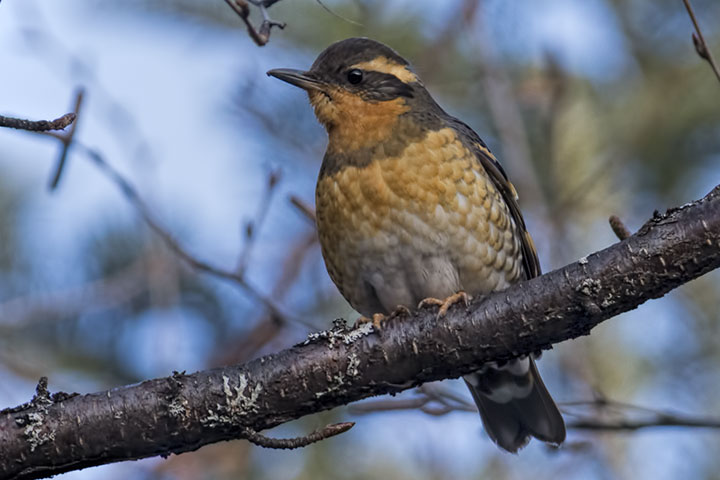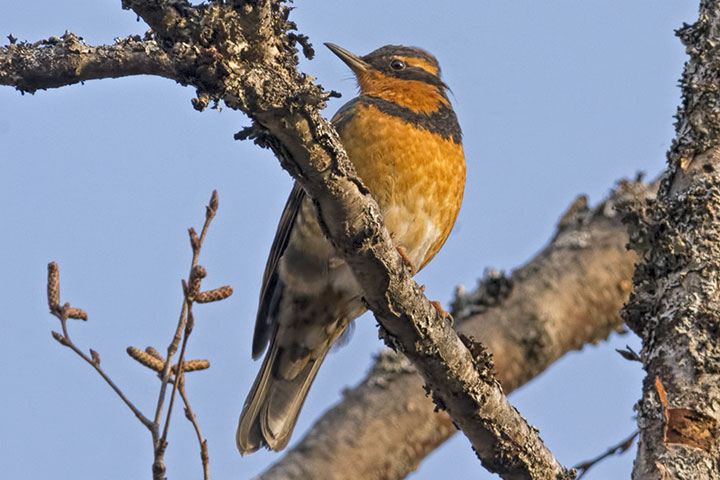This has been a good winter for the Varied Thrush, and now numbers are increasing through migration.
In silhouette, the Varied Thrush looks like its cousin, the American Robin (also a thrush), but they differ in several ways. While the robin is red, bold, and tuneful; the Varied Thrush is orange, elusive and, well, herein lies a problem. Just what is the sound made by this orange bird?
Owing to the bird being elusive, the song of the Varied Thrush is often its only evidence. So, the sound is worth recognizing. Fortunately, there are many recordings available; An example is offered by birdsource.org.
The National Geographic describes this sound as a “series of long, eerie whistles of 1 pitch”. Alas, it is not a single pitch. Although sometimes a rapid trill, it is usually a chord. (The Varied Thrush is not the only bird capable of singing two notes at once.)
Some websites acknowledge that the Varied Thrush does indeed sing a chord. Critters360 offers the “fact” that, “its tone is an F minor”. Hugh Griffith (a BC zoologist) is not quite as specific when he says that it sings, “a disjointed series of randomly, or absent-mindedly selected minor chords.” What they agree upon is that the bird sings a minor chord.
Both sites employ the language of music. However, a minor third is composed of two notes separated by three semitones, and to a musician’s ear, the notes of the thrush’s chord are within a tone (two semitones). The thrush’s chord is certainly distinctive, but its dissonance is not that of a minor chord.
The sound is eerie: a haunting sound of the early morning forest.
Despite the bird’s elusiveness, these pictures were taken this morning.
The female Varied Thrush is a pale orange with a greyish breast band.
The male Varied Thrush is a brighter orange with a black breast band.

Wonderful shots. Another interesting trait is their ability to move through the brush almost silently.
The sound is a telephone ringing.
hmmm. Was this the same pair dancing through the spruce tree in my small garden on Stanley Street on the 23rd? Thanks Alistair!
Alistair, you may be interested to know what I have learned about the varied thrush’s song. I have been recording bird songs since the early 80s, and discovered that when, in the studio, I slow the varied thrush recording down to 1/3 or 1/4 of it’s normal delivery speed, it sounds very, very like a robin’s meandering warble. Ever since this discovery, I like to think of the varied thrush’s singing as that of a robin on speed. Although I understand the difference between our larynx and the songbird syrinx, the notion that the varied thrush is delivering chords may derive from our human ear’s inability to resolve the song’s extremely rapid delivery. Thank you for your always interesting comments! Cheereo…
Peter, this is fascinating. It would take a better sound man, than I am, to know if an exceedingly rapid trill might be heard as a chord. And could one hear a beat frequency arising from the difference? Nevertheless, birds can deliver different sounds from either side of the syrinx and so can produce a chord. Incidentally, the thrush’s trill has a spacing of only about a quarter tone—somewhat less than the chords it produces.
Of course, rather than the varied thrush being a robin on speed, another whimsical take would be that the American Robin is actually a red-shifted Varied Thrush (both in colour and sound). Maybe this opens the possibility that somewhere out there there might be an unseen Infrared Thrush. (I am having too much fun with this.)
My guess is that the authors of sites that said the varied thrush sings a minor chord made the simplistic assumption that as it clearly wasn’t a major chord, it must perforce be a minor one. Alas, there are many other choices.
First, definitely a wrong description here: The National Geographic describes this sound as a “series of long, eerie whistles of 1 pitch”…for I’ve been intrigued by the harbinger of spring sound of the Varied Thrush…whistles at different pitches. And definitely also NOT an f minor chord.
I keep meaning to have my pitch pipe with me when I’m out walking, or I could some morning around our house, if I’m still in the very early morning, to check out the pitches. It’s sounded more to me like a trill, that is more than one pitch just a musical second (space) apart. When I’ve identified if each bird’s song is the same pitches, at least as heard by my ear, I’ll join in the discussion. I’m certainly fascinated by Peter’s discovery of the likeness to the American Robin’s song … sped up!
Thanks,
Karen
The back and forth of the rusty swing at the park in my childhood. I woke up to the sound 1-2 weeks ago here in Rossland; Linda has one at her feeder today. Thanks for the info, all. Sound of Orange – enchanting title, I want to wordnap it.
The breadth and depth of your knowledge never ceases to astound me. Each day that I turn on my computer, your posts are among the first things I read.